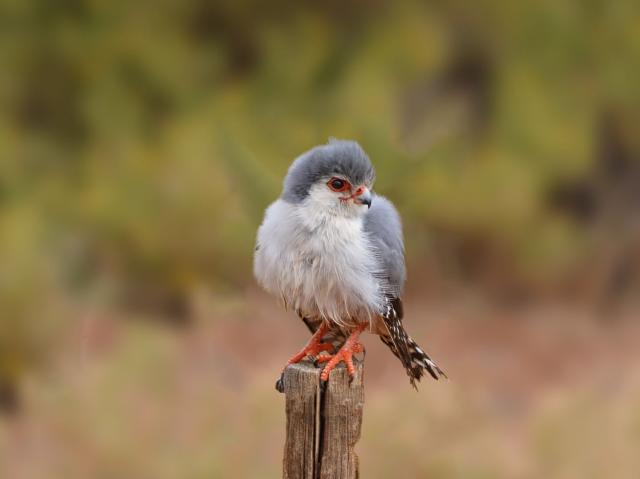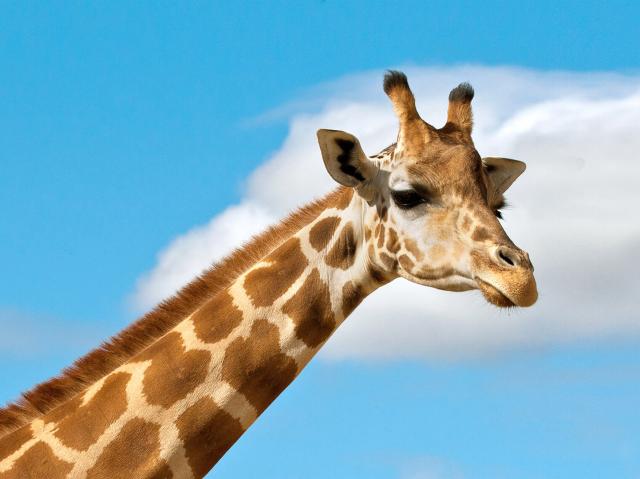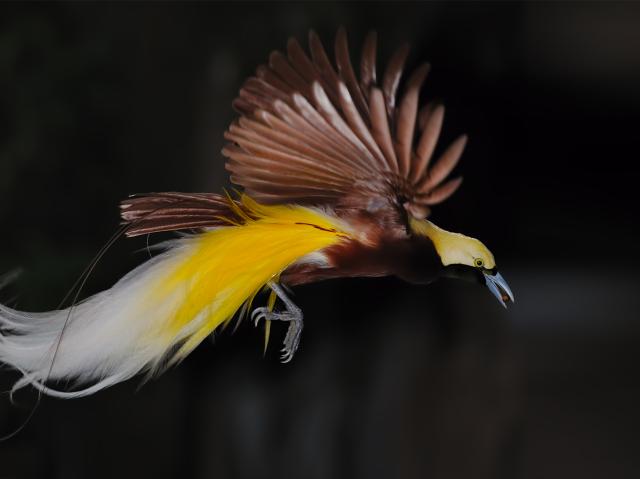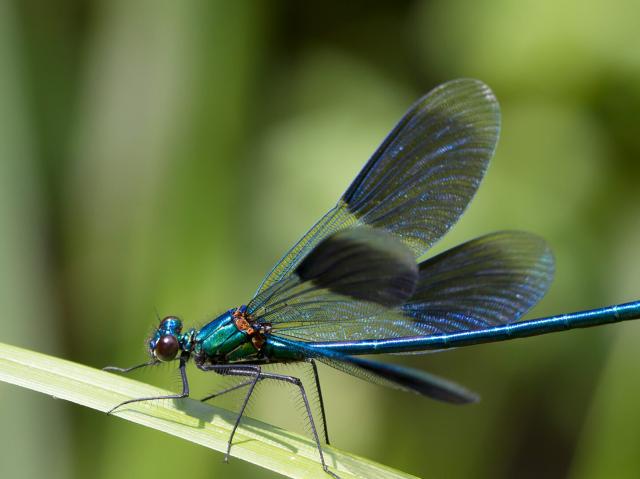
Painted Dog (African Hunting Dog)

- CLASS: Mammalia (Mammals)
- ORDER: Carnivora
- FAMILY: Canidae
- GENUS: Lycaon
- SPECIES: pictus

ABOUT
African painted dogs are classified in the Canidae, or true dog, family along with jackals, foxes, coyotes, wolves, dingoes, and domestic dogs. They are frequently mistaken as hyenas. However, hyenas are different enough to be in a separate taxonomic family, Hyaenidae.
African painted dogs differ from their canid relatives in that they have four toes on their front feet instead of five. Long legs and a lanky body give the dogs both speed and endurance. Large, rounded ears give them excellent hearing and help keep the dogs cool in a hot climate. A pattern of splotches and splashes of black, different shades of brown, and white markings is unique to each individual dog and gives it its common name.
HABITAT AND DIET
Found in the open plains and savannas of Africa, painted dogs can also live and thrive in thicker bush and forest areas. For painted dogs, each day begins with a greeting ceremony. Sounding like a flock of songbirds, the dogs fill the morning air with excited chirps and twitters as the family group, called a pack, gears up for the first hunt of the day. Pack members run shoulder to shoulder and then pause to leap over and dive under each other. The dogs appear to "kiss" one another, licking and poking at the corners of each other's mouth.
But this is really a food-begging behavior that plays an important role in social bonding within the pack. From there, excitement begins to overcome the entire pack until all the dogs are jumping and play fighting with each other, increasing their energy as they prepare to go on the hunt!
African painted dogs hunt twice a day, usually at dawn and dusk. Their disruptive coloration makes the pack look much larger than it really is. This confuses prey and helps the dogs hunt with more success than other African predators. In fact, African painted dogs are one of the most successful hunters in all of Africa, catching prey 70 to 90 percent of the time. (In contrast, lions are only successful 30 to 40 percent of the time.) Thomson's gazelles, impalas, and puku antelope are the main items on the dogs' menu.
The dogs have to eat their kill quickly, before the competition—lions, hyenas, and vultures—get to it. A painted dog pack can finish a full-grown gazelle in as little as eight minutes!
Painted dogs owe part of their success to the way they hunt: they work as a group to catch their prey. They communicate within the pack by making high-pitched vocalizations or squeaks, which sound like a tennis shoe rubbing on a gymnasium floor! If a dog gets lost or separated from the group, it makes a sound, like a bell, called a "hoo" call. They can also signal pack mates by moving their very large ears to show what direction to go or what to do. Unlike wolves and domestic dogs, African painted dogs do not howl.
The dogs do not hunt in the same manner as lions do. Instead, they hunt in a relay form, taking turns running after the prey. Painted dogs depend on their ability to run for a long time without getting tired so they can outlast their prey. They can run up to 37 miles per hour (60 kilometers per hour) for up to 3 miles (4.8 kilometers).
FAMILY LIFE
We are family: African painted dogs are most like wolves in their social structure but seem to be gentler within their pack. The average pack size is between 5 and 20 dogs. There is one dominant male and female, called the alpha pair, in a pack. Still, everyone in the pack gets along very well most of the time. Food sharing is a critical part of pack life. The adult dogs eat and then regurgitate the meat for injured or ill pack members and youngsters.
The alpha female usually gives birth to 10 to 12 pups per litter in a den. The mother may use the underground burrow of an aardvark, warthog, or hyena for her den, or the pack may dig one under a termite mound. The hunters bring food for the mother while she is confined in the den caring for her newborns. Thankfully for the mother, some of the pack members stay to help babysit or guard the den and defend it against predators such as lions and spotted hyenas while the rest of the pack hunts.
Pack members start to feed the pups at about four weeks of age by regurgitating solid food for the youngsters. They are usually weaned when about eight weeks old but continue to use the den as a safe haven until they are up to 16 weeks old. For about three months after the pups are born, the pack hunts closer to home so food (the kill) can be brought to the den to feed both pups and the den helpers, usually adult males. When the pups are old enough to follow the adults to a kill, the hungry hunters step back and watch for other predators while the young eat first.
With most social mammals, such as baboons, lions, and elephants, the females stay with the group and raise their young while the males leave to start new groups. Not so with African painted dogs—they do just the opposite! The females are the ones to leave the pack, sometimes as a group of sisters, to join a new pack when they are about three years old. Males generally remain in the pack they were born into. Therefore, the pack is mostly made up of males and has very few females, sometimes only one.
CONSERVATION
Once found in most parts of Africa south of the Sahara Desert, African painted dogs are now gone from 25 of the 39 countries in which they were found a mere 50 years ago. Packs of 100 or more dogs used to be fairly common, but now these African predators are considered the second-most endangered carnivore (after the Ethiopian wolf) in Africa.
Many factors have contributed to the catastrophic decline in painted dog numbers over the last century. Europeans often regarded painted dogs as pests, and most colonial governments established long-term extermination programs that offered bounties in exchange for painted dog tails. Between 1945 and 1949, as many as 5,000 painted dogs were killed in such a program in Zambia, a number equal to the total populations left in Africa today.
Another problem for painted dogs is habitat loss and fragmentation, as people are moving into more and more of the dogs' territory. Studies show that an African painted dog pack needs between 80 and 800 square miles (207 to 2,070 square kilometers) of land in which to roam and hunt. Unfortunately, most national parks in Africa are not large enough for even one painted dog pack, and family groups living outside protected areas are still killed by farmers and ranchers.
The dogs are also susceptible to diseases carried by domesticated dogs (such as rabies, canine distemper, and parvovirus) and can suffer devastating epidemics if exposed to one of these diseases.
To help conserve this endangered species, San Diego Zoo Wildlife Alliance supports the Northern Rangelands Trust. This community-led conservation program in Kenya promotes the collective management of ecosystems to improve human livelihoods, biodiversity conservation, and rangelands management. The African hunting dog is among the wildlife in the area that benefits from this holistic conservation initiative.
By supporting San Diego Zoo Wildlife Alliance, you are our ally in saving and protecting wildlife worldwide.
LIFE SPAN
Painted dogs in the care of humans have a median life expectancy of about 10 years.
YOUNG
Number of young at birth: Up to 21 in a litter (more than any other kind of dog); average litter size is 10 to 12
Weight at birth: 10.5 to 12 pounds (4.5 to 5.5 kilograms)
Age of maturity: 18 months
SIZE
Length: 2.7 to 4.6 feet (84 to 141 centimeters); females are slightly larger
Height: 24 to 39 inches (61 to 76 centimeters) tall at the shoulder
Weight: 40 to 75 pounds (18 to 34 kilograms); males are slightly heavier
FUN FACTS
Constant wanderers, painted dogs rarely stay in one place more than a day or two.
Fossil remains seem to suggest that the painted dog split from its canid relatives about three million years ago.
It has been recorded that an adult painted dog will look for days for a lost pup or juvenile, calling out with a special vocalization and listening for a reply to bring the lost dog back to the pack.










